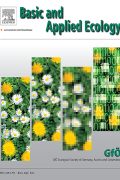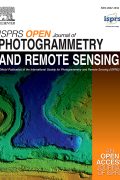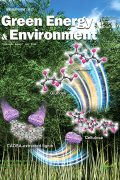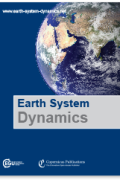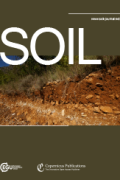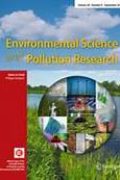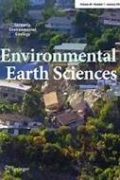OpenAlex Research Search
Keywords
Author
Loading...
Environmental studies is a multidisciplinary academic field which systematically studies human interaction with the environment. Environmental studies connect principles from the physical sciences...Wikipedia
Conferences
-
International Conference on Environmental Science and GreeWFGA-SFTIC-NFGA 2025 Joint Conference June 23rd – June 27th, 2025

-
International Conference of KSFE-FETEC June 30 - July 2, 2025 in Seoul, South Korea

-
The 3rd International Online Conference on Agriculture 22–24 October 2025

-
33rd Annual Conference of AERA 9-11 October 2025

-
The International Society for Ecological Modelling Global Conference 19-23 October 2025

-
The 11th World Conference on Ecological Restoration (SER2025) 30 September - 4 October 2025 | Denver, United States

Books
E-Books
Use the below Call Number/s to browse books on shelves available on first floor of library:
- 300, 570, 930
You can access books via Library Catalogue and check availability.
List of some Books available in library is given below:
- 300, 570, 930
You can access books via Library Catalogue and check availability.
List of some Books available in library is given below:
The HDFC Library provides access to wide range of eBooks to support your research journey.
Use this E-Book guide to know how to access eBooks
The ProQuest eBooks central is major database having Environmental Studies and Ecology eBooks. List of some eBooks is given below:
(Note: To access books the below given books you must be logged in to eLibrary portal)
Use this E-Book guide to know how to access eBooks
The ProQuest eBooks central is major database having Environmental Studies and Ecology eBooks. List of some eBooks is given below:
(Note: To access books the below given books you must be logged in to eLibrary portal)
Journals
Referred Articles
| Article | DOI |
|---|---|
| Comparative Proteomic Analysis of Arabidopsis Mature Pollen and Germinated Pollen | link |
| Land! : The Case for an Agrarian Economy | link |
| Forest Ecosystems : Analysis at Multiple Scales | link |
| Forest Canopies : Forest Production, Ecosystem Health and Climate Conditions | link |
| Uncovering forest dynamics using historical forest inventory data and Landsat time series | link |
| Rate-of-change analysis in paleoecology revisited: A new approach | link |
| Behavioral threat and appeasement signals take precedence over static colors in lizard contests | link |
| Literature for 1915 on the behavior of spiders and insects other than ants | link |
| Predicting spatial aspects of human–elephant conflict | link |
| Lessons From 20 Years of Human–Elephant Conflict Mitigation in Africa | link |
| Human–Elephant Conflicts in Northeast India | link |
| Human-Elephant conflict mitigation methods: A review of effectiveness and sustainability | link |
| Zoochosis: A short review on stereotypical behavior of captive animals | link |
| Perceptions and Patterns of Human–elephant Conflict in Old and New Settlements in Sri Lanka: Insights for Mitigation and Management. | link |
| Elephants as actors in the political ecology of human–elephant conflict | link |
| Touching Trunks: Elephants, Ecology and Compassion in Three Southern African Teen Novels | link |
| Ecological consequences of forest elephant declines for Afrotropical forests | link |
| Review: Elephant Evolution, Ecology, and Conservation Biology | link |
| Reproductive Ecology of the Female African Elephant | link |
| Foraging Ecology of Northern Elephant Seals | link |
| Marine foraging ecology influences mercury bioaccumulation in deep-diving northern elephant seals | link |
| Elephant Hunting in 19th-Century Kenya: Kamba Society and Ecology in Transformation | link |
| Pathogen spillover driven by rapid changes in bat ecology | link |
| Ecology of the Asian Elephant in Southern India. I. Movement and Habitat Utilization Patterns | link |
| Habitat and Movement Ecology of Grizzly Bears in the Mackenzie Delta, NWT | link |
| Understanding movement data and movement processes: current and emerging directions | link |
| Trends in Ecology & Evolution | link |
| A Report on Animal Behaviour: Ethology | link |
| Investigating trends in human-wildlife conflict: is conflict escalation real or imagined? | link |
| Human-Wildlife Conflict: Global Policy and Perception Insights | link |
| Human-wildlife conflict: A bibliometric analysis during 1991–2023 | link |
| Trends of Human-Wildlife Conflicting in Kali Tiger Reserve Forest, Karnataka, South India | link |
| Human–wildlife conflict in the roof of the world: Understanding multidimensional perspectives through a systematic review | link |
| Assessing and evaluating human-wildlife interactions for coexistence in shared landscapes | link |
| Coexistence between human and wildlife: the nature, causes and mitigations of human wildlife conflict around Bale Mountains National Park, Southeast Ethiopia | link |
| Coupling movement and landscape ecology for animal conservation in production landscapes | link |
| Bumblebee resilience to climate change, through plastic and adaptive responses | link |
| A century of advances in bumblebee domestication and the economic and environmental aspects of its commercialization for pollination | link |
| Diet effects on bumblebee health | link |
| The Physiological and Genomic Bases of Bumble Bee Social Behaviour | link |
| Chance and adaptation in the evolution of island bumblebee behaviour | link |
| Plant-pollinator interactions in New Caledonia influenced by introduced honey bees | link |
| Honey as an Ecological Reservoir of Antibacterial Compounds Produced by Antagonistic Microbial Interactions in Plant Nectars, Honey and Honey Bee | link |
| honey bee nectar foragers and their implications for plant–pollinator interactions | link |
| Stingless bees in applied pollination: practice and perspectives | link |
| Information flow and organization of stingless bee foraging | link |
| Recruitment communication in stingless bees (Hymenoptera, Apidae, Meliponini) | link |
| Floral Rewards: Alternatives to Pollen and Nectar | link |
| Differential Floral Rewards and Pollination by Deceit in Unisexual Flowers | link |
| The Co-Radiations of Pollinating Insects and Angiosperms in the Cretaceous | link |
| Pollination Syndromes and Floral Specialization | link |
| Generalization in Pollination Systems, and Why it Matters | link |
| Pollinators, Flowering Plants, and Conservation Biology | link |
| Pollination Biology and the Relative Importance of Nocturnal and Diurnal Pollinators in Three Species of Sonoran Desert Columnar Cacti | link |
| Herbivory and Plant Defenses in Tropical Forests | link |
| Plant exposure to herbivore-induced plant volatiles: a sustainable approach through eliciting plant defenses | link |
| A host-specialized aphid lineage helps another conspecific lineage utilize a new host by disrupting the plant defenses. | link |
| Induction of plant defenses: the added value of zoophytophagous predators. | link |
| The dual function of elicitors and effectors from insects: reviewing the ‘arms race’ against plant defenses. | link |
| Regulation of tradeoffs between plant defenses against pathogens with different lifestyles | link |
| Remote sensing of future competitors: Impacts on plant defenses | link |
| Signals and transduction mechanisms for activation of plant defenses against microbial attack | link |
| Analyzing plant defenses in nature | link |
| Plant sex and the evolution of plant defenses against herbivores | link |
| Optimal Foraging: On Flower Selection by Bees | link |
| Optimal foraging: Random movement by pollen collecting bumblebees. | link |
| Energetically optimal foraging strategy is emergent property of time-keeping behavior in honey bees | link |
| Automata, matching and foraging behavior of bees | link |
| Optimal Foraging Theory. | link |
| Branching patterns: the simulation of plant architecture | link |
| Remaking bean plant architecture for efficient production | link |
| Manipulating plant architecture with members of the CETS gene family | link |
| Effects of Habitat Fragmentation on Biodiversity | link |
| STATUS OF FRAGMENTATION MODELS | link |
| Plant–animal interactions in the era of environmental DNA (eDNA)—A review | link |
| Types, evolution and significance of plant – animalinteractions | link |
| Buzz pollination: studying bee vibrations on flowers | link |
| The foraging behaviour of honey bees, Apis mellifera: A review | link |
| Foraging behaviour and preference of pollen sources by honey bee (Apis mellifera) relative to protein contents | link |
| The potential and realized foraging movements of bees are differentially determined by body size and sociality | link |
| A Method to Study Honey Bee Foraging Regulatory Molecules at Different Times During Foraging | link |
| The Problem of Fragmentation and the Need for Integrative Solutions | link |
| Habitat fragmentation and its lasting impact on Earth’s ecosystems | link |
| Herbivory: effects on plant abundance, distribution and population growth | link |
| Insect herbivory within modern forests is greater than fossil localities | link |
| Plant diversity effects on herbivory are related to soil biodiversity and plant chemistry | link |
| OPTIMAL FORAGING AND RISK OF PREDATION: EFFECTS ON BEHAVIOR AND SOCIAL STRUCTURE IN UNGULATES | link |
| Honeybee keeping constraints and future prospects | link |
| Bumble bee movement ecology: foraging and dispersal across castes and life stages | link |
| Beekeeping with stingless bees: a new type of hive | link |
| Stingless bee propolis: composition, biological activities and its applications in the food industry | link |
| Determining the minimum number of pollen grains needed for accurate honey bee (Apis mellifera) colony pollen pellet analysis | link |
| Template-Guided Protein Structure Prediction and Refinement Using Optimized Folding Landscape Force Fields | link |
| Ten Years of Landscape Genomics: Challenges and Opportunities. | link |
| A practical guide to environmental association analysis in landscape genomics | link |
| Landscape Genomics: A Brief Perspective | link |
| Aquatic Landscape Genomics and Environmental Effects on Genetic Variation | link |
| Redundancy analysis: A Swiss Army Knife for landscape genomics | link |
| The Value of Biodiversity | link |
| Wildlife, biodiversity and trade | link |
| THE BIODIVERSITY CRISIS, BIODIVERSITY HOTSPOTS, AND OUR OBLIGATIONS WITH RESPECT TO THEM | link |
| Consequences of changing biodiversity. | link |
| Biodiversity: measurement and estimation. Preface | link |
| Deriving Field-Based Species Sensitivity Distributions (f-SSDs) from Stacked Species Distribution Models (S-SDMs) | link |
| Species distribution modeling in the cloud | link |
| A Sensitivity Analysis of the Application of Integrated Species Distribution Models to Mobile Species: A Case Study with the Endangered Baird’s Tapir | link |
| Study on selecting sensitive environmental variables in modelling species spatial distribution | link |
| New trends in species distribution modelling | link |
| Species Distribution Models: Ecological Explanation and Prediction Across Space and Time | link |
| Effects of sample size on the performance of species distribution models | link |
| Correlation and process in species distribution models: bridging a dichotomy | link |
| Species distribution models and ecological theory: A critical assessment and some possible new approaches | link |
| The continuing challenges of testing species distribution models | link |
| bioclim: the first species distribution modelling package, its early applications and relevance to most current MaxEnt studies | link |
| Sensitivity of predictive species distribution models to change in grain size | link |
| Bio-ORACLE: a global environmental dataset for marine species distribution modelling | link |
| The Application of Predictive Modelling of Species Distribution to Biodiversity Conservation | link |
| Integrating species distribution modelling into decision-making to inform conservation actions. Biodivers Conserv | link |
| Predicting organismal response to marine heatwaves using dynamic thermal tolerance landscape models | link |
| Development and Delivery of Species Distribution Models to Inform Decision-Making | link |
| June 2024 issue | |
| From nemoral to boreal forest: Mid‐ and late‐Holocene forest dynamics in the Småland Uplands, southern Sweden | link |
| Temperate forest dynamics and carbon storage: a 26-year case study from Orange Kloof Forest, Cape Peninsula, South Africa | link |
| Selection and quality assessment of Landsat data for the North American forest dynamics forest history maps of the US | link |
| Spatial analysis of forest cover and quality dynamics of Jalthal forest in the Jhapa district, Nepal | link |
| Effects of the lack of forest management on spatiotemporal dynamics of a subalpine Pinus cembra forest | link |
| Extreme events and climate change: the post-disaster dynamics of forest fires and forest storms in Sweden | link |
| Forest Transitions in the United States, France and Austria: dynamics of forest change and their socio- metabolic drivers | link |
| New Zealand forest dynamics: a review of past and present vegetation responses to disturbance, and development of conceptual forest models | link |
| Typhoon Disturbance and Forest Dynamics: Lessons from a Northwest Pacific Subtropical Forest | link |
| Hurricane Effects on Forest Ecosystems in the Caribbean | link |
| Variable effects of climate on forest growth in relation to climate extremes, disturbance, and forest dynamics | link |
| Suburban Forest Change and Vegetation Water Dynamics in Atlanta, USA | link |
| Bison, anthropogenic fire, and the origins of agriculture in eastern North America | link |
| Who Framed the Forest Fire? State Framing and Peasant Counter-Framing of Anthropogenic Forest Fires in Spain Since 1940 | link |
| The "Fire Stick Farming" Hypothesis: Australian Aboriginal Foraging Strategies, Biodiversity, and Anthropogenic Fire Mosaics | link |
| Mapping fire ignition risk in a complex anthropogenic landscape | link |
| Dynamics of an Anthropogenic Fire Regime | link |
| Spatial and temporal patterns of global burned area in response to anthropogenic and environmental factors: Reconstructing global fire history for the 20th and early 21st centuries | link |
| Bark thickness does not explain the different susceptibility of Australian and New Zealand temperate rain forests to anthropogenic fire | link |
| Anthropogenic modifications to fire regimes in the wider Serengeti‐Mara ecosystem | link |
| Mosaics of fire and water: the co-emergence of anthropogenic landscapes and intensive seed exploitation in the Australian arid zone | link |
| Preliminary Pollen Analysis of Some Apple Cultivars in Kashmir: Towards Understanding the Apple Pollen Morphology | link |
| Reconstruction of Late Glacial Conditions of Exogenic Landscape Formation of Central Kamchatka: Data on Spore–Pollen Analysis | link |
| Pollen Analysis, Chemical Composition and Antibacterial Activity of Anatolian Chestnut Propolis Collected From Yıgılca Region | link |
| Dynamics of Forest Vegetation and Climate in the Southern Taiga of Western Siberia in the Late Holocene According to Spore–Pollen Analysis and Ams Dating of the Peat Bog | link |
| Spatial and temporal environmental pollen analysis of footwear worn in the area of Barcelos, North-West Portugal, in a forensic context | link |
| Exploring pre-neolithic environmental dynamics: paleoecology around the Göbekli Tepe based on a multiproxy approach in southeastern Türkiye | link |
| On the Application of Spore-Pollen Analysis in the Study of Archaeological Sites Using the Example of the Settlement of Syroy Agan 24 | link |
| Land cover classification in a mixed forest-grassland ecosystem using LResU-net and UAV imagery | link |
| Above- and belowground ecosystem biomass, carbon and nitrogen allocation in recently afforested grassland and adjacent intensively managed grassland | link |
| Bautin bifurcations in a forest-grassland ecosystem with human-environment interactions | link |
| Vegetation history, recent dynamics and future prospects of a Hungarian sandy forest-steppe reserve: forest-grassland relations, tree species composition and size-class distribution | link |
| Late Pleistocene human paleoecology in the highland savanna ecosystem of mainland Southeast Asia | link |
| The problem of the Quaternary, geological environment and desertification | link |
| Valuation of agricultural land-use scenarios with choice experiments: a political market share approach | link |
| The Ridgefield Multiple Ecosystem Services Experiment: Can restoration of former agricultural land achieve multiple outcomes? | link |
| Land-Use Change and Environmental Properties Alter the Quantity and Molecular Composition of Soil-Derived Dissolved Organic Matter | link |
| EFFECTS OF HISTORICAL LAND USE AND FOREST PATCH SIZE ON MYRMECOCHORES AND ANT COMMUNITIES | link |
| Why forests need wildfires - The Economist | link |
| Historical Land-Use/Land-Cover Changes in a Bottomland Hardwood Forest, Bayou Fountain, Louisiana | link |
| Influence of Land-Use Intensification on Vegetation C-Stocks in an Alpine Valley from 1865 to 2003 | link |
| HISTALP—historical instrumental climatological surface time series of the Greater Alpine Region | link |
| Spatial genetic structure and reproductive success in fragmented and continuous populations of PRIMULA VULGARIS | link |
| Understanding dairy farmers' trade-offs between environmental, social and economic sustainability attributes in feeding systems: The role of farmers' identities | link |
Recent Trends
Behavioral Ecology and Movement Ecology |Population Decline and Threats |
Human-Elephant Conflict |The Value of Elephants |New Method for Studying Animal Behavior | Ethology the Study of Animal Behavior |
Animal Behavior and Conservation |
Forest Dynamics |
Forest Dynamics |
Internet/Blog Articles
| Title | Access |
|---|---|
| Britannica | link |
| BYJU'S | link |
| Khan Academy | link |
| GSE NEWSLETTER | link |
| International Elephant Foundation | link |
| Elephanatics Newsletter | link |
| Elephant Tales Newsletter | link |
| Newscientist | link |
| Wildlife Institute of India | link |
| June 2024 issue | |
| Positive Pyschology | link |
| Pyschcentral | link |
| gradPSYCH Blog | link |
| Healthyplace | link |
| Mind Hacks | link |
| PsyBlog | link |
| Pyschology Today | link |
| The positive pyschology People | link |
| Success Consciousness | link |
| South African College of Applied Psychology | link |
| Psychology Today India | link |
| Quantitative data-collection methods | link |
| Microaggressions at work: Recognizing & overcoming our biases | link |
| The hidden threat to belonging? Don't let microaggressions tank your team | link |
| Microaggressions are a big deal: How to talk them out and when to walk away | link |
| Intergroup Contact Theory: Past, Present, and Future | link |
| What Is Social Psychology? Definition, Key Terms, and Examples | link |
| An Overview of Social Psychology | link |
| Social Psychology and Influences on Behavior | link |


